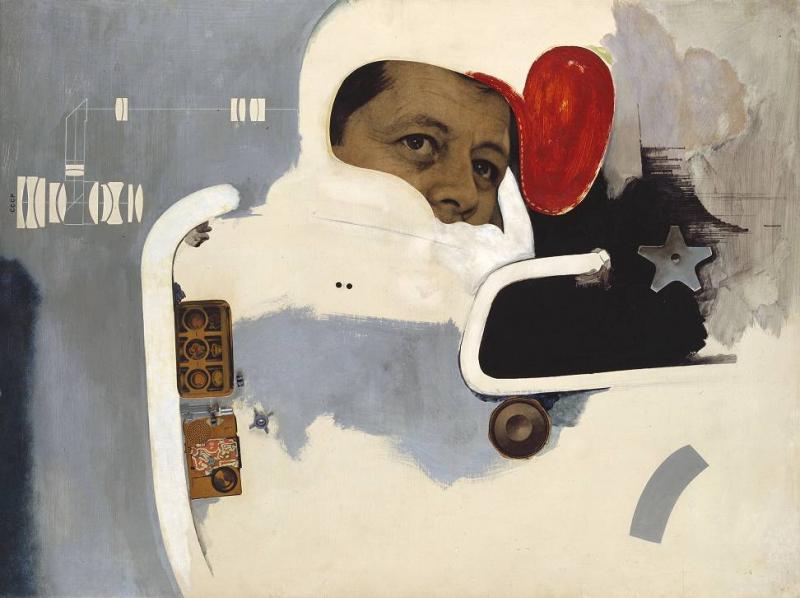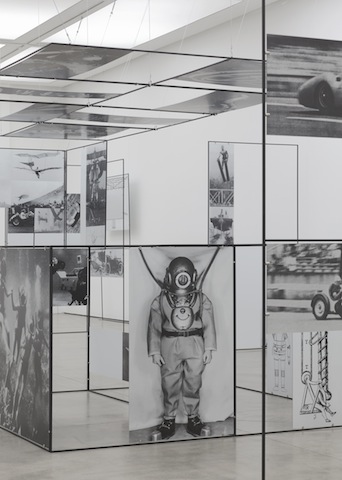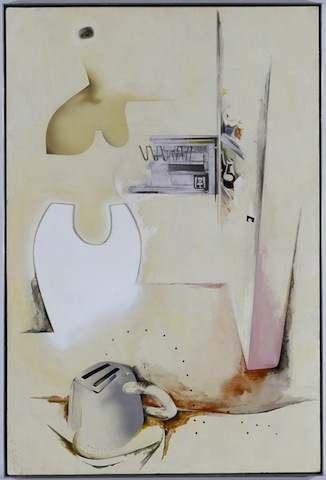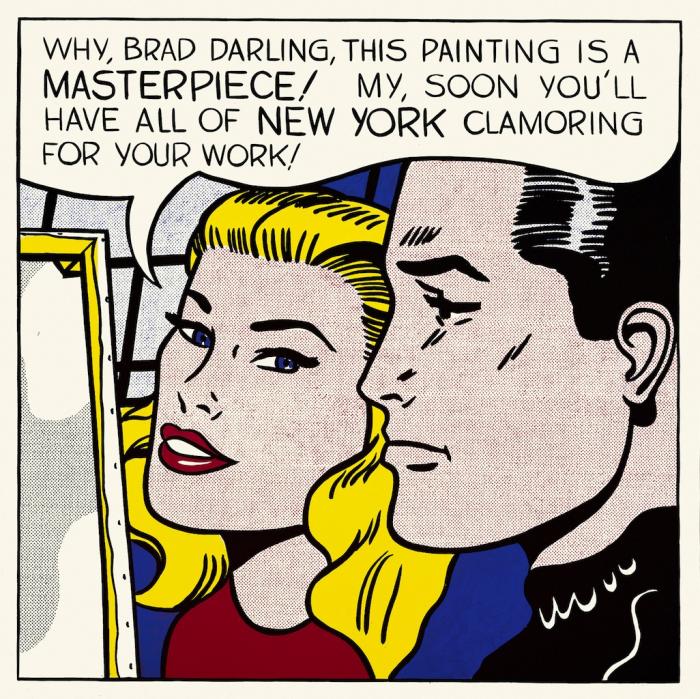Richard Hamilton, Tate Modern /ICA | reviews, news & interviews
Richard Hamilton, Tate Modern /ICA
Richard Hamilton, Tate Modern /ICA
At last, the British 'father of Pop art' gets the retrospective he deserves

Some artists are diminished by major retrospectives, including those artists we consider great. A gap opens up between what you see and what you hear, which is why you can never judge work with your ears, or at least your ears and nothing else.
I can think of a few examples at random – Gauguin is one (yes, I think he is), Edward Hopper (not a “giant”, but what verbiage he attracts for a figurative artist with very limited range and imagination and just one or two enduring paintings) is without question another. And having two Lichtenstein surveys in one decade does reinforce how some good ideas should come with their own self-destruct button.
One of the things that’s so good about this superb retrospective is how many surprises it offers
But just as there are artists who disappoint the more you see, there are those who, the more you see, the greater they become. And this despite the works that you’d rather wish they hadn’t done - and there are certainly some of those with regard to Richard Hamilton. There are works that seem too crude, too obvious for his penetrating, analytical mind. But we’ll come to those in a minute.
You have to see a whole body of work by Hamilton to fully appreciate him, and you have to see this retrospective to see that he is even better than the vague “father of British Pop art” esteem we currently hold him in. He’s influential, of course, part of a major zeitgeist-that-was and that extended over some three decades. His influence as a founder member of the Independent Group, a small group of artists and architects, critics and designers who met at the ICA in the Fifties to discuss and disseminate ideas about the newly emergent “consumer culture”, runs deep. His preoccupation with design also ran deep. (Pictured below: Interior II, 1968; © Tate)
 But even if he’d ploughed a lonelier furrow, his body of work would reveal what a deeply fascinating artist he was and is. And that’s the only way a major retrospective can succeed – we see that it can’t just be influence, at one or two significant moments of a career, that count, but the body and range of work. A retrospective lays that bare, since you can’t measure influence by any physical contact with the work. What you can measure is how good the actual work is and, in Hamilton’s case, how it’s fed by so many different ideas. Hamilton, that father of British Pop and important pioneer of immersive installation art, is actually so much more.
But even if he’d ploughed a lonelier furrow, his body of work would reveal what a deeply fascinating artist he was and is. And that’s the only way a major retrospective can succeed – we see that it can’t just be influence, at one or two significant moments of a career, that count, but the body and range of work. A retrospective lays that bare, since you can’t measure influence by any physical contact with the work. What you can measure is how good the actual work is and, in Hamilton’s case, how it’s fed by so many different ideas. Hamilton, that father of British Pop and important pioneer of immersive installation art, is actually so much more.
One of the things that’s so good about this superb retrospective is how many surprises it offers. The Tate has ambitiously set about reconstructing several installations. Opening the exhibition is the earliest, Growth and Form, from 1951 (Hamilton made it as part of an exhibition design for the Festival of Britain). Inspired by the Scottish biologist D’arcy Wentworth Thompson’s On Growth and Form, 1917, a rival theory to Darwin’s Origin of Species, the light-dimmed room presents a strange kind of Surrealist laboratory.
On a grid-based frame plaster models of cell structures loom large, while elsewhere there's footage of cells dividing, a bubbling test-tube, the skull of a large mammal, eggs from different bird species, and models of molecular structures. A large portrait photograph of an unknown man, simply listed as “Head”, greets you as you enter, nudging you towards ambivalence. The postwar optimism that wanted society made anew, and which included the inexhaustible possibilities of science (and, of course, exemplified by the Festival of Britain) isn’t, I think, presented as a straightforward cause for celebration. There’s a hint – a possible hint – of something of Orwell and Aldous Huxley behind Hamilton’s homage.
Celebration and critique are two approaches that often run parallel in much of Hamilton’s best work, including Fun House, an installation he created with architect John Voelker and artist John McHale for the seminal This is Tomorrow exhibition at Whitechapel Gallery in 1956, an exhibition now only famous for the collage that heralded the birth of Pop art, Hamilton’s Just what is is that makes the modern home so different, so appealing?.
Fun House is plastered with a mash-up of images from Hollywood, sci-fi, advertising and fine art. A bouncy foam carpet gives off a pleasant strawberry odour, and on a spectacular jukebox Fifties hits are spun. Meanwhile, a microphone invites you to “Speak Here”. This is art for the demotic age, with a populace headily seduced by Americana and mass-media culture.
 For something more coolly detached (most of Hamilton’s work is a cerebral infusion of cool detachment and implicit critique, and sometimes offered in the guise of art-as-information, that now familiar conceptual trope), the ICA presents two reconstructions of walk-through installations that were both mounted at the institute: Man, Machine and Motion, 1955 (pictured right), and Exhibit, 1957, the latter conceived with Victor Pasmore and critic Lawrence Alloway, and which is something like a 3D Mondrian. The earlier piece, occupying the ICA’s ground floor, presents historical images of different modes of transportation – documentary, diagrammatic, fantastical, speculative – on horizontal and vertical plates mounted on modular grids. Linnaeus fashion, the images are classified according to method of transport. This is image data, rather than empirical data.
For something more coolly detached (most of Hamilton’s work is a cerebral infusion of cool detachment and implicit critique, and sometimes offered in the guise of art-as-information, that now familiar conceptual trope), the ICA presents two reconstructions of walk-through installations that were both mounted at the institute: Man, Machine and Motion, 1955 (pictured right), and Exhibit, 1957, the latter conceived with Victor Pasmore and critic Lawrence Alloway, and which is something like a 3D Mondrian. The earlier piece, occupying the ICA’s ground floor, presents historical images of different modes of transportation – documentary, diagrammatic, fantastical, speculative – on horizontal and vertical plates mounted on modular grids. Linnaeus fashion, the images are classified according to method of transport. This is image data, rather than empirical data.
 Back at the Tate, there is much to ponder and absorb, far too much to outline here. The relationship between sex, machinery and consumerism is just as successfully and wittily explored in the fractured curves and orifices featured in the painting $he, 1958-61 (pictured left), as it is in Just what is it…? And then there’s Hamilton’s meticulous reconstruction of Duchamp’s The Large Glass. Duchamp’s influence was a guiding principle in all of Hamilton’s endeavours. But the older artist was assimilated rather than borrowed from, for style and consistency of style was an anathema to Hamilton; it's an analytical way of thinking that provides the thread that links the work, and that connects it to Duchamp.
Back at the Tate, there is much to ponder and absorb, far too much to outline here. The relationship between sex, machinery and consumerism is just as successfully and wittily explored in the fractured curves and orifices featured in the painting $he, 1958-61 (pictured left), as it is in Just what is it…? And then there’s Hamilton’s meticulous reconstruction of Duchamp’s The Large Glass. Duchamp’s influence was a guiding principle in all of Hamilton’s endeavours. But the older artist was assimilated rather than borrowed from, for style and consistency of style was an anathema to Hamilton; it's an analytical way of thinking that provides the thread that links the work, and that connects it to Duchamp.
Where Hamilton falters is in his later, political work (though his three Northern Ireland paintings, The Citizen, The Subject, and The State, 1982-83, must be his best). He always possessed a pronounced didactic streak, but it was leavened by an appreciation of ambiguity – you can never quite pin the work down – as well as brilliant wit. But seeing Blair dressed as a cowboy, with his hands on his holsters in Shock and Awe, 2010, or a television set seeping blood as it shows images of the first Gulf war, remind me painfully of Harold Pinter’s late foray into anti-war poetry. It's when the balance tipped in ambiguity’s favour that Hamilton made truly great work. And this is a great, unmissable survey.
GREAT POP ART RETROSPECTIVES
Allen Jones, Royal Academy. A brilliant painter derailed by an unfortunate obsession
Andy Warhol: The Portfolios, Dulwich Picture Gallery. An exhibition of still lifes which are anything but still
 Ed Ruscha: Fifty Years of Painting, Hayward Gallery. First British retrospective for a modern master
Ed Ruscha: Fifty Years of Painting, Hayward Gallery. First British retrospective for a modern master
Lichtenstein: A Retrospective, Tate Modern. The heartbeat of Pop Art is given the art-historical credit as he deserves (pictured above, Lichtenstein's Masterpiece, 1962)
Patrick Caulfield, Tate Britain. A late 20th-century great emerges into the light
Pauline Boty: Pop Artist and Woman, Pallant House Gallery. The paintings are wonderful, but the curator does a huge disservice to this forgotten artist
Explore topics
Share this article
The future of Arts Journalism
You can stop theartsdesk.com closing!
We urgently need financing to survive. Our fundraising drive has thus far raised £49,000 but we need to reach £100,000 or we will be forced to close. Please contribute here: https://gofund.me/c3f6033d
And if you can forward this information to anyone who might assist, we’d be grateful.

Subscribe to theartsdesk.com
Thank you for continuing to read our work on theartsdesk.com. For unlimited access to every article in its entirety, including our archive of more than 15,000 pieces, we're asking for £5 per month or £40 per year. We feel it's a very good deal, and hope you do too.
To take a subscription now simply click here.
And if you're looking for that extra gift for a friend or family member, why not treat them to a theartsdesk.com gift subscription?
more Visual arts
 'We are bowled over!' Thank you for your messages of love and support
Much-appreciated words of commendation from readers and the cultural community
'We are bowled over!' Thank you for your messages of love and support
Much-appreciated words of commendation from readers and the cultural community
 Lee Miller, Tate Britain review - an extraordinary career that remains an enigma
Fashion photographer, artist or war reporter; will the real Lee Miller please step forward?
Lee Miller, Tate Britain review - an extraordinary career that remains an enigma
Fashion photographer, artist or war reporter; will the real Lee Miller please step forward?
 Kerry James Marshall: The Histories, Royal Academy review - a triumphant celebration of blackness
Room after room of glorious paintings
Kerry James Marshall: The Histories, Royal Academy review - a triumphant celebration of blackness
Room after room of glorious paintings
 Folkestone Triennial 2025 - landscape, seascape, art lovers' escape
Locally rooted festival brings home many but not all global concerns
Folkestone Triennial 2025 - landscape, seascape, art lovers' escape
Locally rooted festival brings home many but not all global concerns
 Sir Brian Clarke (1953-2025) - a personal tribute
Remembering an artist with a gift for the transcendent
Sir Brian Clarke (1953-2025) - a personal tribute
Remembering an artist with a gift for the transcendent
 Emily Kam Kngwarray, Tate Modern review - glimpses of another world
Pictures that are an affirmation of belonging
Emily Kam Kngwarray, Tate Modern review - glimpses of another world
Pictures that are an affirmation of belonging
 Kiefer / Van Gogh, Royal Academy review - a pairing of opposites
Small scale intensity meets large scale melodrama
Kiefer / Van Gogh, Royal Academy review - a pairing of opposites
Small scale intensity meets large scale melodrama
 Jenny Saville: The Anatomy of Painting, National Portrait Gallery review - a protégé losing her way
A brilliant painter in search of a worthwhile subject
Jenny Saville: The Anatomy of Painting, National Portrait Gallery review - a protégé losing her way
A brilliant painter in search of a worthwhile subject
 Abstract Erotic, Courtauld Gallery review - sculpture that is sensuous, funny and subversive
Testing the boundaries of good taste, and winning
Abstract Erotic, Courtauld Gallery review - sculpture that is sensuous, funny and subversive
Testing the boundaries of good taste, and winning
 Edward Burra, Tate Britain review - watercolour made mainstream
Social satire with a nasty bite
Edward Burra, Tate Britain review - watercolour made mainstream
Social satire with a nasty bite
 Ithell Colquhoun, Tate Britain review - revelations of a weird and wonderful world
Emanations from the unconscious
Ithell Colquhoun, Tate Britain review - revelations of a weird and wonderful world
Emanations from the unconscious
 Rachel Jones: Gated Canyons, Dulwich Picture Gallery review - teeth with a real bite
Mouths have never looked so good
Rachel Jones: Gated Canyons, Dulwich Picture Gallery review - teeth with a real bite
Mouths have never looked so good

Add comment